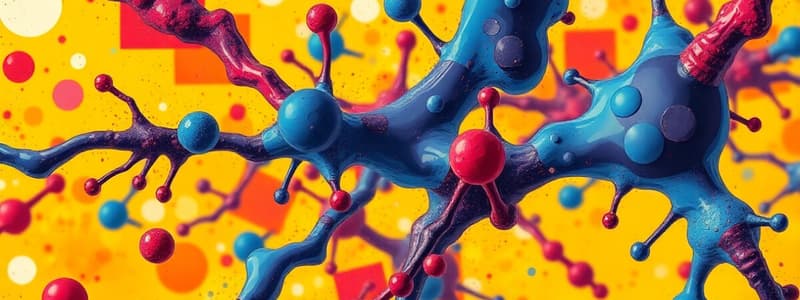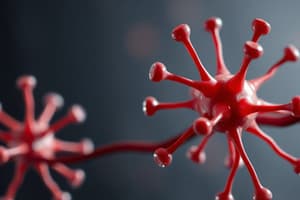Podcast
Questions and Answers
Flashcards
Sympathomimetic Drugs
Sympathomimetic Drugs
Drugs that mimic the effects of the sympathetic nervous system.
Norepinephrine vs. Amphetamine
Norepinephrine vs. Amphetamine
Norepinephrine has -OH groups, while amphetamine does not.
Alpha-Carbon Addition
Alpha-Carbon Addition
Alpha-carbon group addition makes a drug resistant to MAO.
Amino End Group Size
Amino End Group Size
Signup and view all the flashcards
Direct-Acting Agonists
Direct-Acting Agonists
Signup and view all the flashcards
Norepinephrine receptor affinity
Norepinephrine receptor affinity
Signup and view all the flashcards
Epinephrine receptor affinity
Epinephrine receptor affinity
Signup and view all the flashcards
Alpha-1 Blockers in the Eye
Alpha-1 Blockers in the Eye
Signup and view all the flashcards
Beta Blockers in the Eye
Beta Blockers in the Eye
Signup and view all the flashcards
Beta-1 Blockers in the Heart
Beta-1 Blockers in the Heart
Signup and view all the flashcards
Alpha-1 Blockers in Blood Vessels
Alpha-1 Blockers in Blood Vessels
Signup and view all the flashcards
Alpha Blockers and Vasodilation
Alpha Blockers and Vasodilation
Signup and view all the flashcards
Beta-2 Blockers in Bronchi
Beta-2 Blockers in Bronchi
Signup and view all the flashcards
Beta-2 Blockers in GI Tract
Beta-2 Blockers in GI Tract
Signup and view all the flashcards
Alpha-1 Blockers in GI Tract
Alpha-1 Blockers in GI Tract
Signup and view all the flashcards
Study Notes
- Sympathomimetic drugs mimic the effects of sympathetic nervous system activation.
- Norepinephrine differs from amphetamine due to the presence of -OH groups.
- The presence of -OH groups in Norepinephrine makes it a catecholamine.
- Absence of one or both -OH groups leads to decreased potency at adrenergic receptors.
- Absence of one or both -OH groups increases susceptibility to COMT.
- Addition of a group on the α-carbon makes the compound resistant to MAO.
- Addition of a group on the amino end alters receptor affinity.
- Larger groups on the amino end decrease α-receptor activity and increase β-receptor activity.
Direct Acting Agonists
- Direct-acting agonists directly bind to and activate adrenergic receptors.
Mixed Acting Agonists
- Mixed-acting agonists have both direct and indirect actions on adrenergic receptors.
- Norepinephrine has receptor affinities of α1=α2, β1>>β2, requiring very high concentrations to activate β2.
- Epinephrine has receptor affinities of α1=α2, β1=β2, and binds to all receptors due to its methyl group.
Alpha Adrenergic Agonists
- Phenylephrine has receptor selectivity of α1>>α2.
- Clonidine has receptor selectivity of α1>α2.
- Yohimbine has receptor selectivity of α1>α2
Beta Adrenergic Agonists
- Propranolol has receptor affinities of β1=β2.
- Butoxamine has receptor selectivity of β2>>>β1.
- In most organs, the sympathetic nervous system (SNS) and parasympathetic nervous system (PSNS) are physiological antagonists.
- Adrenergic antagonists often have the same effect as PSNS activation.
Effects of Adrenergic Antagonists on the Eye
- Blocking α1 receptors causes pupil constriction.
- Blocking β2 and β1 receptors decreases the production of aqueous humor.
Effects of Adrenergic Antagonists on the Heart
- Blocking β1 receptors decreases heart rate and force of contraction.
Effects of Adrenergic Antagonists on Blood Vessels
- Blocking α1 receptors causes vasodilation.
- Blocking β2 receptors causes vasoconstriction.
Baroreceptor Reflex Response
- The baroreceptor reflex is a homeostatic mechanism that helps maintain blood pressure.
Beta-Blockers and Baroreceptor Reflex
- Inhibition of β1 receptors decreases heart rate and force of contraction.
- Baroreceptors detect decreased blood pressure.
- Decreased blood pressure leads to decreased PSNS and increased SNS activation.
- Increased SNS activation causes vasoconstriction via α1 receptors.
Alpha-Blockers and Baroreceptor Reflex
- Inhibition of α1 receptors in blood vessels leads to vasodilation.
- Baroreceptors detect decreased blood pressure, leading to decreased PSNS and increased SNS activation.
- Increased SNS activation increases heart rate via β1 receptors.
Effects of Adrenergic Antagonists on the Bronchi
- Blocking β2 receptors causes bronchoconstriction.
Effects of Adrenergic Antagonists on the GI Tract
- Blocking β2 receptors increases motility.
- Blocking α2 receptors increases ACh release and motility.
- Blocking α1 receptors relaxes the sphincter.
Effects of Adrenergic Antagonists on the Urinary Bladder
- Blocking β2 receptors contracts the bladder wall.
- Blocking α1 receptors relaxes the sphincter.
Studying That Suits You
Use AI to generate personalized quizzes and flashcards to suit your learning preferences.




